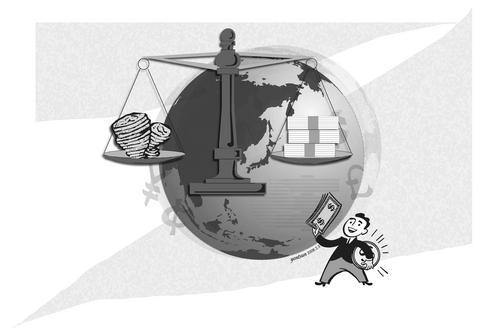Everyone wants economic stability, and many are reluctant to abandon today what gave them stability yesterday. But trying to obtain stability from rigidity is illusory. The stability of the international financial system today depends on the willingness of countries with rigid exchange rates to allow greater flexibility.
In the aftermath of the international financial crisis of 1997 and 1998, many emerging markets found themselves -- through currency depreciation, rapid productivity gains, or both -- highly competitive. Countries that ran significant current-account surpluses, built up large reserves, and fixed (or heavily managed) their exchange rates in order to support the first two objectives that appeared to secure external stability.
The irony is that the crisis of 1997and 1998 was one in which a particular system of exchange-rate pegs failed when capital flowed out. Yet, in many ways, accumulating reserves worked better than anyone could have imagined -- countries found they could withstand considerable shocks and growth was impressive both domestically and globally. So, within a few years, many countries concluded their pegs could work fine if supported by big enough war chests of official reserves. A new type of order emerged in the world's exchange rate system.

There were, of course, some less desirable spillover effects on others. If a considerable fraction of the world economy wants to run a current-account surplus (by 2006, this included much of emerging Asia, most oil exporters, and Japan), an equal share of the world economy must run a deficit. In the period after 1998, the US provided most of the entire required deficit.
As long as US assets were attractive to residents of surplus countries (or there was an acceptable chain of investments from surplus countries that ended in the US), these accumulations of reserves were sustainable. The IMF worried a great deal about what would happen when this chain broke -- and the eventual break was, of course, more a matter of arithmetic than economics. The US current-account deficit can persist above roughly 3 percent of GDP only if unrealistic assumptions are made about the share of US assets that the rest of the world is willing to hold.
The policy plans announced by China, the euro area, Japan, Saudi Arabia, and the US last spring -- in the context of the IMF's Multilateral Consultation on global imbalances -- represent the international community's response to the rising risks. The US is to reduce its deficit, with the surplus countries proposing sensible steps to bring down their surpluses in ways that support global growth.
The sense of urgency in these discussions has increased in recent months, as the global situation has grown more complex. Specifically, problems in the US housing sector have, since summer, undermined confidence in securitized assets. The net result has been to shift global portfolio preferences in ways that have affected some exchange rates significantly.
The US dollar has depreciated in a way that helps global adjustment and fortunately does not disrupt the US government securities market; long-term rates are in fact down from July, so adjustment has been "orderly." Yet the pattern of exchange-rate movements in the rest of the world has been largely unrelated to existing current-account positions.
In fact, currencies of surplus countries with heavily managed exchange rates have actually depreciated in real effective terms since the summer, creating inflationary pressure and frustrating global adjustment.
This has also shifted the burden of adjustment disproportionately onto countries with floating currencies, such as the euro and the Canadian and Australian dollar. The lack of adjustment of surplus countries with inflexible exchange rate-regimes means that as the US deficit falls, a counterbalancing deficit develops elsewhere in the world -- along with real effective exchange rate appreciation.
Knowing what to do in this increasingly complex and volatile situation is the easy part: Look at the Multilateral Consultation policy plans and "just do it."
As the US Treasury's recent semiannual report to the US Congress noted, for China these plans are to "rebalance its economy: boosting domestic demand and consumption-led growth; reforming its financial system; and achieving greater flexibility in its exchange-rate regime. Indeed, rebalancing the pattern of growth is a central economic goal of China's leadership."
But expanding demand and allowing real effective exchange rate appreciation in China will not be enough if other countries do not do their part. Oil exporters must increase fiscal spending further; Japan and the euro area must trigger higher growth through structural reforms; and the US must implement concrete measures to sustain higher savings.
This would help maintain confidence that the adjustment process will remain orderly and free of new global imbalances or protectionism. Implementing the policy commitments from the multilateral consultation is also needed to avoid a loss of confidence in the US dollar.
The risks to global growth will increase as long as adjustment remains uneven. The politics is not so simple, but we need cooperation between countries to reduce these risks, and we need it now.
Simon Johnson is economic counselor at the IMF and Jonathan Ostry is deputy director of the IMF's Research Department. Copyright: Project Syndicate

In the past month, two important developments are poised to equip Taiwan with expanded capabilities to play foreign policy offense in an age where Taiwan’s diplomatic space is seriously constricted by a hegemonic Beijing. Taiwan Foreign Minister Lin Chia-lung (林佳龍) led a delegation of Taiwan and US companies to the Philippines to promote trilateral economic cooperation between the three countries. Additionally, in the past two weeks, Taiwan has placed chip export controls on South Africa in an escalating standoff over the placing of its diplomatic mission in Pretoria, causing the South Africans to pause and ask for consultations to resolve
An altercation involving a 73-year-old woman and a younger person broke out on a Taipei MRT train last week, with videos of the incident going viral online, sparking wide discussions about the controversial priority seats and social norms. In the video, the elderly woman, surnamed Tseng (曾), approached a passenger in a priority seat and demanded that she get up, and after she refused, she swung her bag, hitting her on the knees and calves several times. In return, the commuter asked a nearby passenger to hold her bag, stood up and kicked Tseng, causing her to fall backward and
In December 1937, Japanese troops captured Nanjing and unleashed one of the darkest chapters of the 20th century. Over six weeks, hundreds of thousands were slaughtered and women were raped on a scale that still defies comprehension. Across Asia, the Japanese occupation left deep scars. Singapore, Malaya, the Philippines and much of China endured terror, forced labor and massacres. My own grandfather was tortured by the Japanese in Singapore. His wife, traumatized beyond recovery, lived the rest of her life in silence and breakdown. These stories are real, not abstract history. Here is the irony: Mao Zedong (毛澤東) himself once told visiting
When I reminded my 83-year-old mother on Wednesday that it was the 76th anniversary of the founding of the People’s Republic of China, she replied: “Yes, it was the day when my family was broken.” That answer captures the paradox of modern China. To most Chinese in mainland China, Oct. 1 is a day of pride — a celebration of national strength, prosperity and global stature. However, on a deeper level, it is also a reminder to many of the families shattered, the freedoms extinguished and the lives sacrificed on the road here. Seventy-six years ago, Chinese Communist leader Mao Zedong (毛澤東)